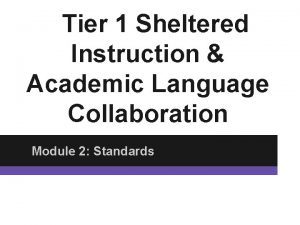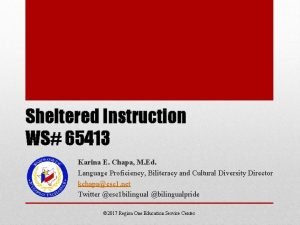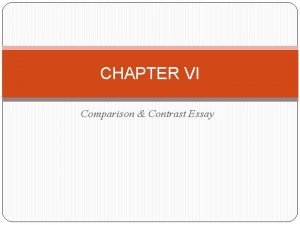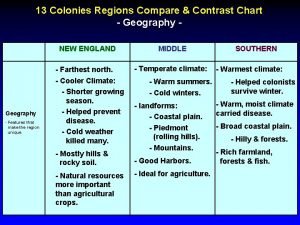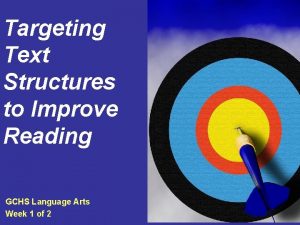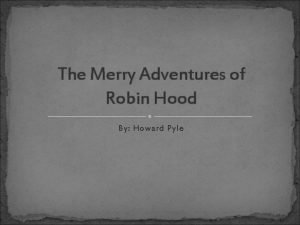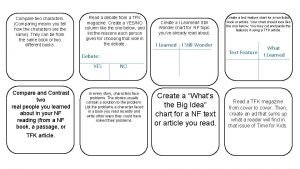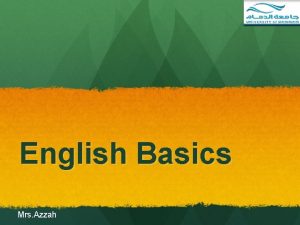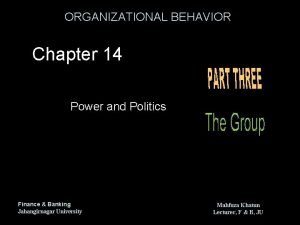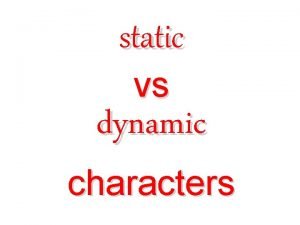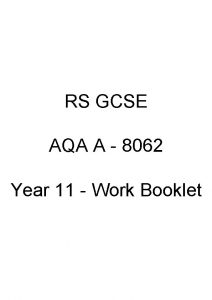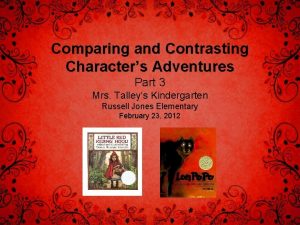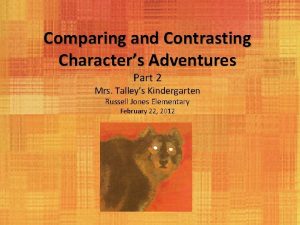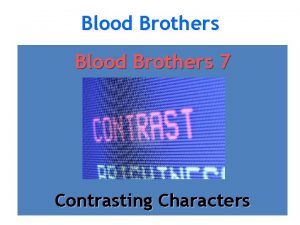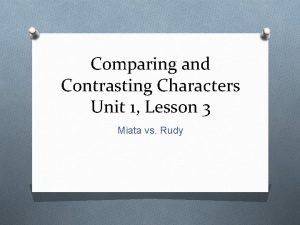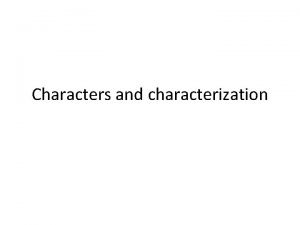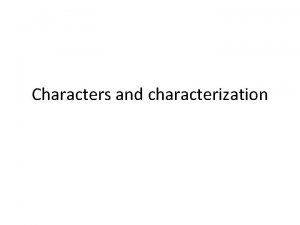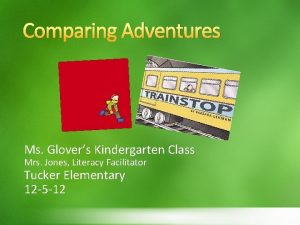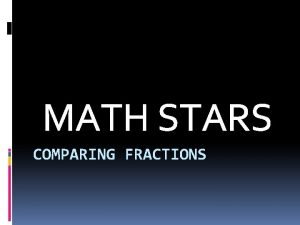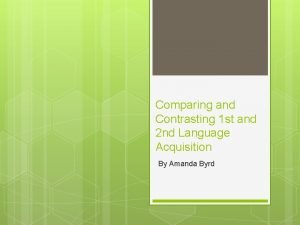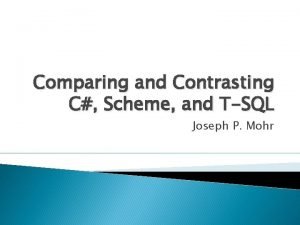Comparing and Contrasting Characters Adventures Part 3 Mrs



















- Slides: 19

Comparing and Contrasting Character’s Adventures Part 3 Mrs. Talley’s Kindergarten Russell Jones Elementary February 23, 2012

Mrs. Talley and Mrs. Hensley continued working with the standard and activity from the previous days’ lessons. RL. K. 9 With prompting and support, compare and contrast the adventures and experiences of characters in familiar stories.

This lesson focused on comparing the “adventures” in two stories. RL. K. 9 With prompting and support, compare and contrast the adventures and experiences of characters in familiar stories.

Because many of Mrs. Talley’s students are language learners, this lesson was planned to incorporate the following language objectives: Language Objectives: Listening: Listen to literature from diverse cultures and respond appropriately using one or two word phrases (e. g. , retelling, dramatizing) (ELPL. 1. K-2. 8) Speaking: Respond appropriately- EL 1 one or two word phrases, EL 2 simple sentences (ELPL. 1. K-2. 8) Reading: Answer questions (ELPR. 4. K-2. 4) Writing: Apply strategies, when prompted, to move from oral to written language (ELPW. 7. K-2. 4)

(2) Identifying Similarities and Differences (3) Summarizing and Note Taking (4) Reinforcing Effort and Providing Recognition (7) Cooperative Learning (8) Setting Objectives and Providing Feedback (9) Generating and Testing Hypotheses (5) Homework and Practice (6) Nonlinguistic Representations (10) Cues, Questions and Advance Organizers GANAG gives students the opportunity to actively use the nine high-yield strategies.

Goal: I can compare the adventures in two stories. Students scored themselves to the goal with a thumbs up or down. (8) Setting Objectives and Providing Feedback

Access Prior Knowledge “Look at these two pictures. How are they the same? ” A student helped Ms. Hensley model talking with a partner and then making a partner pyramid. Partners shared their responses. (7) Cooperative Learning (10) Cues, Questions and Advance Organizers

New Information “Today our goal is to compare the adventures of two stories. ” “There are three steps we need to follow when we want to compare. ” 1. I can find the items to compare. “What are we going to compare today? ” (2) Identifying Similarities and Differences

1. I can find the items to compare. 2. I can choose the features to compare. With prompting and support, the students identified the “features” of the matrix from the previous lessons. • characters • setting • adventure

After identifying “adventure” as the feature to compare, students acted out the adventure from each story. Little Red Riding Hood The huntsman cut the wolf open to rescue Little Red Riding Hood and her grandma. Lon Po Po The sisters use all their strength to pull the wolf up before dropping him. (6) Nonlinguistic Representations

1. I can find the items to compare. 2. I can choose the features to compare. 3. I can tell how the items are the same or different. “How are the adventures in these two stories the same? ” Students shared their ideas.

Ms. Hensley modeled thinking about how the adventures were the same. Then she modeled writing about her ideas. The wolves in both stories had big teeth. They both wanted to eat someone.

Application Students wrote about how the character’s adventures in both stories were the same. (5) Homework and Practice

Mrs. Talley scored students performance of the standard using a clipboard and scoring guide.

Ms. Hensley and Mrs. Talley selected students to share their writing. The wolf knock on the door. A wolf go to grandmas house. I felt scared. (4) Reinforcing Effort and Providing Recognition

On Little Red Riding Hood and Lon Po Po they both have wolf. On little Red Riding Hood and Lon Po Po they both have grandmas in the story.

It was scary. They both have big ears. The stories both have wolves in the books.

Goal: I can compare the adventures in two stories. Students revisited the goal and scored themselves with a thumbs up or down. (8) Setting Objectives and Providing Feedback

Marzano, R. J. , Pickering, D. J. , & Pollock, J. E. (2001). Classroom instruction that works: Research-based strategies for increasing student achievement. Alexandria, VA: Association for Supervision and Curriculum Development. Pollock, J. E. (2007). Improving student learning one teacher at a time. Alexandria, VA: Association for Supervision and Curriculum Development. Pollock, J. E. , & Ford, Sharon M. (2009). Improving student learning one principal at a time. Alexandria, VA: Association for Supervision and Curriculum Development.
 Compare and contrast hinduism and buddhism
Compare and contrast hinduism and buddhism Meaning of compare and contrast
Meaning of compare and contrast Karina is writing a paragraph comparing and contrasting
Karina is writing a paragraph comparing and contrasting Karina is writing a paragraph comparing and contrasting
Karina is writing a paragraph comparing and contrasting Compare and contrast signal words
Compare and contrast signal words 13 colonies economy chart
13 colonies economy chart Compare and contrast examples
Compare and contrast examples The merry adventures of robin hood characters
The merry adventures of robin hood characters They are mrs garcia and mrs castro
They are mrs garcia and mrs castro They are mrs garcia and mrs castro
They are mrs garcia and mrs castro Monitoring comparing and correcting work
Monitoring comparing and correcting work Comparing two characters
Comparing two characters Mrs. darling was ___________ of mrs. s.
Mrs. darling was ___________ of mrs. s. Bought a beautiful dress at the mall
Bought a beautiful dress at the mall Curved lines that are used to blend and soften
Curved lines that are used to blend and soften Illegitimate political behaviour
Illegitimate political behaviour Contrasting leadership and power
Contrasting leadership and power What is a dynamic character
What is a dynamic character Unit 5 international business m2
Unit 5 international business m2 Religious beliefs about helping victims of war
Religious beliefs about helping victims of war


